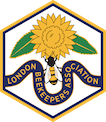
|
London Beekeepers' Association |

|
London Beekeepers' Association |
SeedsThank you for purchasing your pollinator mix seeds from the LBKA. By purchasing and planting our seed mix you are helping to support pollinators through the provision of pollen and nectar rich flowers for them to feed on, and supporting the educational and outreach work of the London Beekeepers Association. About your seed mixYour seed packets have a best before or sow by date, which means they will grow best if sown in spring before this date. If sown later than this some, but not all, of the seeds will germinate and grow, but at a lower rate of success the longer they are left. Each packet contains a blend of 40 annual species which have been specially selected for their attractiveness to pollinators, based on 20 years of research into pollinator flower preferences. The mix contains 5 natives (Field Poppy, Cornflower, Corn marigold, Calendula & Corn Cockle) as well as near natives from Northern Europe and North America, all of which are beneficial to bees and other pollinators. Some of the non-native species in the mix include Annual Larkspur, Salvia, Tagetes, Nemophila, Poached Egg Plant, Limonium, Candy Tuft, Cosmos, Echium Blue Bedder, California Poppy, Love-in-a-mist, Coreopsis, Phacelia, Rocket, Borage, Chrysanthemum, Annual Flax, Lavatera and Stock. This mix has a very long flowering season and will provide food for insect pollinators for much of the late spring, summer and autumn when sown early. A wide variety of bees, butterflies, hoverflies, pollinating beetles and moths will benefit from the display. Our mix has been put together by husband and wife team Dr Karin Alton and Dr Steve Alton from Flowerscapes. Karin works at the University of Sussex as a Honey Bee researcher and Steve is a well-respected ecologist and botanist who formerly lead Kew's Millennium Seed Bank, collecting the majority of the UK's native seeds held in its seed vault. Your mix grows no taller than 50cm in height, but most of the flowers are shorter growing than this, so won't flop over path edges or require supports to grow. Where to plant?This mix is suitable for gardens, urban parks, informal borders, tubs and containers. Because this mix contains non-natives it is not suitable for use on land designated as a nature reserve. How to plant?Clear your ground of all weeds and grasses. Break up clods of soil and rake to a fine tilth. Scatter seeds to cover 1 square meter. To make sowing easier mix seeds with a little compost or sharp sand. Water seeds in and keep watered until they germinate. Once established, this mix is tolerant of dry soils and in normal conditions won't require watering. For best results sow March to May as soon as average day temperatures have risen above 15 Celsius. The first blooms should appear within 6 weeks of germination. A succession of blooms will follow until first frosts of winter. At the end of the season cut down dead flowers, shake off the seed heads to dislodge seed and cultivate the ground. Some of the hardier flowers will come true from seed the following year but for best results re-sow. Please send us pictures of your flowers progress over the summer to forage@lbka.org.uk or tweet them to us @londonbeekeeper |
©2025 London Beekeepers' Association |